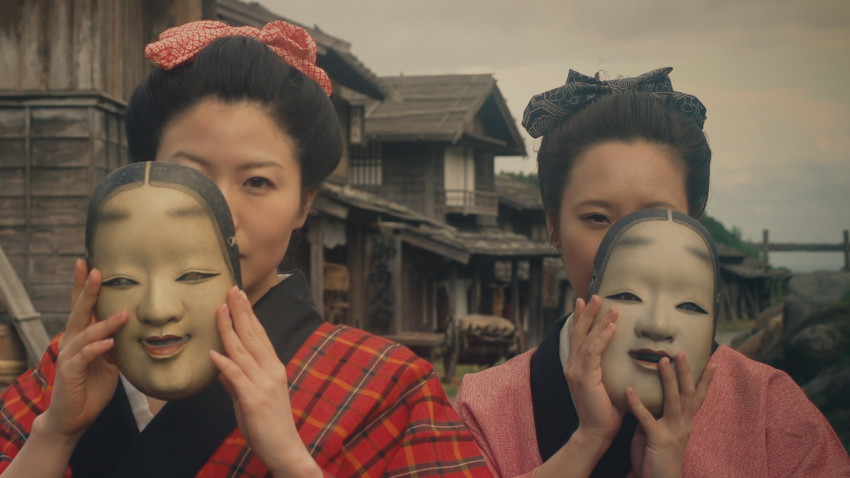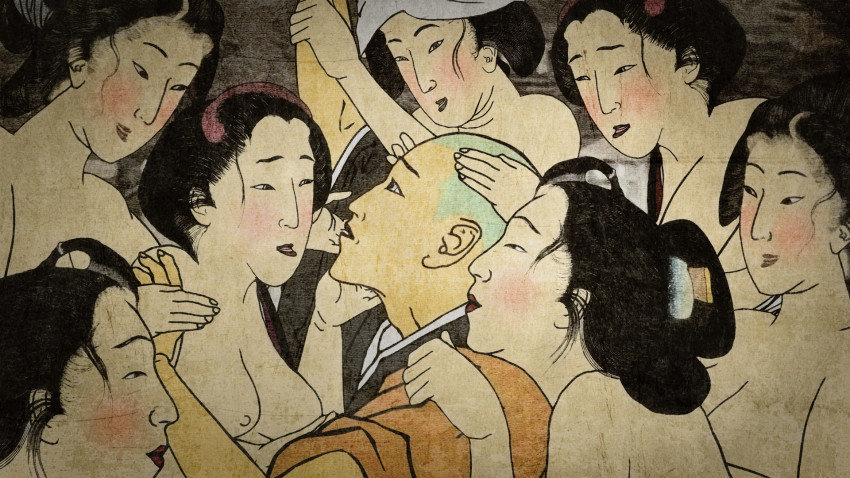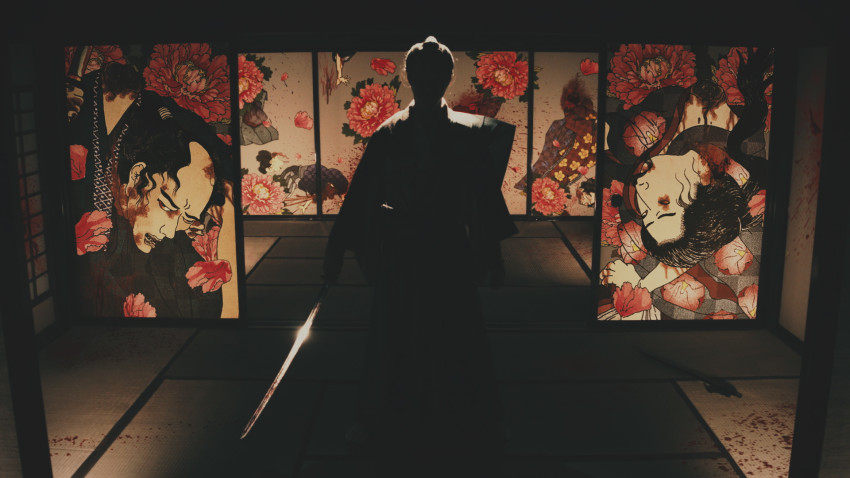Suffering of Ninko
July 22, 2018 · 0 comments
By Jasper Sharp.
 Ninko is a zealous young Buddhist monk of the Edo era. The cause of his suffering, his cross to bear so to speak, is that he is catnip to the ladies. And oh, how he suffers! A simple trip into town on his daily alms round runs the risk of him being overrun by the local lovelies. He is no safer from lascivious eyes back in the cloistered all-male confines of his temple, either.
Ninko is a zealous young Buddhist monk of the Edo era. The cause of his suffering, his cross to bear so to speak, is that he is catnip to the ladies. And oh, how he suffers! A simple trip into town on his daily alms round runs the risk of him being overrun by the local lovelies. He is no safer from lascivious eyes back in the cloistered all-male confines of his temple, either.
As Ninko’s meditations are overwhelmed by profane visions triggered by a traumatic encounter in the nearby woods, his attempts to shield himself in a relentless stream of sutras fail to purge his mind of these earthly distractions. Images of cavorting naked figures with CG-airbrushed nipples and pudenda assail his mind, their faces similarly blurred in hazy mirages or concealed by Noh masks, eventually driving him to seizure.
The only remedy is to take a temporary break from temple life and head off on a pilgrimage. Here he plunges beneath the icy cold spray of a mountain waterfall in an attempt to subdue his ungodly thoughts, but alas, again to no avail. Later on his travels he encounters a wandering samurai named Kanzo, standing over a bloody corpse. Claiming innocence of the murder, the warrior leads the monk on a trail through the uplands to the near-deserted village of Akatsuki, where the male population has been decimated by a ghostly seductress, Yama-Onna (Mountain Woman). She roams the surrounding woodlands, draining her victims of their sap to leave just desiccated husks. Her encounter with Ninko, however, will soon become the stuff of legend.
 There are those of us of a certain age who will vividly recall that magical time in the early 1990s when Japan’s pop-cultural presence enjoyed a sudden surge in the British zeitgeist. This was the era of Sonic the Hedgehog on the Sony Mega Drive and coin-ops videogames like Tekken and Street Fighter II. Channel 4 catered for a generation weaned on BBC airings of Battle of the Planets and Monkey in the late-1970s with the likes of Kazuko’s Karaoke Klub and the Creature Feature series of Godzilla movies in the late-night post-pub slot. In the wake of Akira, the country learned of a new phenomenon then termed commonly referred to as ‘manga’ but which of course we now know as anime, with titles like Urotsukidoji: Legend of the Overfiend provoking a wave of indignant rage in the national tabloids. Meanwhile in the arthouse, Shinya Tsukamoto’s Tetsuo and Tetsuo II provided many with their gateway drug into a wild and exciting world of a national cinema that had been largely absent from British screens over the past decade. The ICA held the country’s first Seijun Suzuki retrospective, while oddball pink film offerings like Takahisa Zeze’s Dream of Garuda and Hisayasu Sato’s The Bedroom began appearing on video shop shelves for rental, packaged up as art. We’d not seen the likes of such things ever before before.
There are those of us of a certain age who will vividly recall that magical time in the early 1990s when Japan’s pop-cultural presence enjoyed a sudden surge in the British zeitgeist. This was the era of Sonic the Hedgehog on the Sony Mega Drive and coin-ops videogames like Tekken and Street Fighter II. Channel 4 catered for a generation weaned on BBC airings of Battle of the Planets and Monkey in the late-1970s with the likes of Kazuko’s Karaoke Klub and the Creature Feature series of Godzilla movies in the late-night post-pub slot. In the wake of Akira, the country learned of a new phenomenon then termed commonly referred to as ‘manga’ but which of course we now know as anime, with titles like Urotsukidoji: Legend of the Overfiend provoking a wave of indignant rage in the national tabloids. Meanwhile in the arthouse, Shinya Tsukamoto’s Tetsuo and Tetsuo II provided many with their gateway drug into a wild and exciting world of a national cinema that had been largely absent from British screens over the past decade. The ICA held the country’s first Seijun Suzuki retrospective, while oddball pink film offerings like Takahisa Zeze’s Dream of Garuda and Hisayasu Sato’s The Bedroom began appearing on video shop shelves for rental, packaged up as art. We’d not seen the likes of such things ever before before.
Nowadays, a national cinema once renowned for providing something dramatically different from the norm is looking remarkably samey in its output. How could one resist, then, a title described by Variety as “beyond weird even by Japanese standards”?
Norihiro Niwatsukino’s tongue-in-cheek blend of flesh and fantasy is certainly the kind of oddball offering that would not have looked out of place nestling alongside the likes of these aforementioned examples all those decades ago. In fact, its distributor Third Window Film’s recent release of Mushi Pro’s A Thousand & One Nights and Cleopatra reminded me of a long-forgotten title from the early days of anime fandom that came out in the UK around this time on VHS, The Sensualist (1991). This was an adaptation of Saikaku Ihara’s 17th century novel and celebration of Edo-era eroticism, The Life of an Amorous Man, scripted by the director of the Animerama films, Eiichi Yamamoto.
 Suffering of Ninko certainly has the kind of strong cultural odour that Japanophiles will find difficult to resist, with its fusion of live-action and animations based on Edo-era shunga erotic woodcuts and a narrative about a young Buddhist monk drawn from his ascetic path by the lure of carnality that recalls Kyoka Izumi’s atmospheric novella The Holy Man of Mount Koya (1900).
Suffering of Ninko certainly has the kind of strong cultural odour that Japanophiles will find difficult to resist, with its fusion of live-action and animations based on Edo-era shunga erotic woodcuts and a narrative about a young Buddhist monk drawn from his ascetic path by the lure of carnality that recalls Kyoka Izumi’s atmospheric novella The Holy Man of Mount Koya (1900).
There is also a freshness about it missing from the kind of safe committee-led productions that seem to have become the standard in contemporary Japanese cinema, as Third Window Film’s head honcho Adam Torel is often prone to rail against. Suffering of Ninko is a resolutely independent work, crowd-funded and obviously low-budget, but never cheap-looking, owing to the fact that its director evidently understands the language of cinema. The film is full of striking compositions, aided by a well-judged use of not too much CG, and well thought-through sound design.
Like Tsukamoto’s debut with Tetsuo, it is clearly the vision of one man who in the process of putting the production together has left his own fingerprints all over the shop. Niwatsukino had a hand in almost every aspect of the finished product, including writing, directing, producing, editing, costumes, animation and special effects. Prior to this feature debut, his works include a number of music videos, the live-action short Strawberry Jam (2010) and three 4 minute episodes of his own animation series called Onizushi [http://onizushi.com/].
Clearly a contender for future cult-movie status, and a rather self-conscious one, let’s face it, Suffering of Ninko main limitation is a 70-minute running time that doesn’t allow much room for narrative invention or sophistication. In fact, rather than feeling compromised by budgetary constraints, one does come away feeling that the material feels slightly stretched to make it up to feature length.
I have to say, I found Suffering of Ninko to be a fun and engaging watch, and certainly never a chore, although it is not going to appeal to everyone. It is a title that is likely to have viewers wavering between the two poles of “I’ve never seen anything like it before” and “Move along, there is nothing new to see here”, depending on their age and familiarity with Japan’s cinema. At the very least, it is a herald of better things to come from a director who, with a bigger budget, looks like a very exciting proposition indeed.
Suffering of Ninko is released on dual format DVD/Blu-ray by Third Window.
Leave a Reply